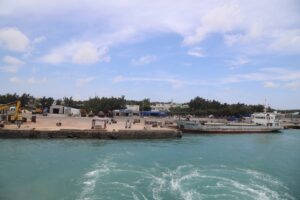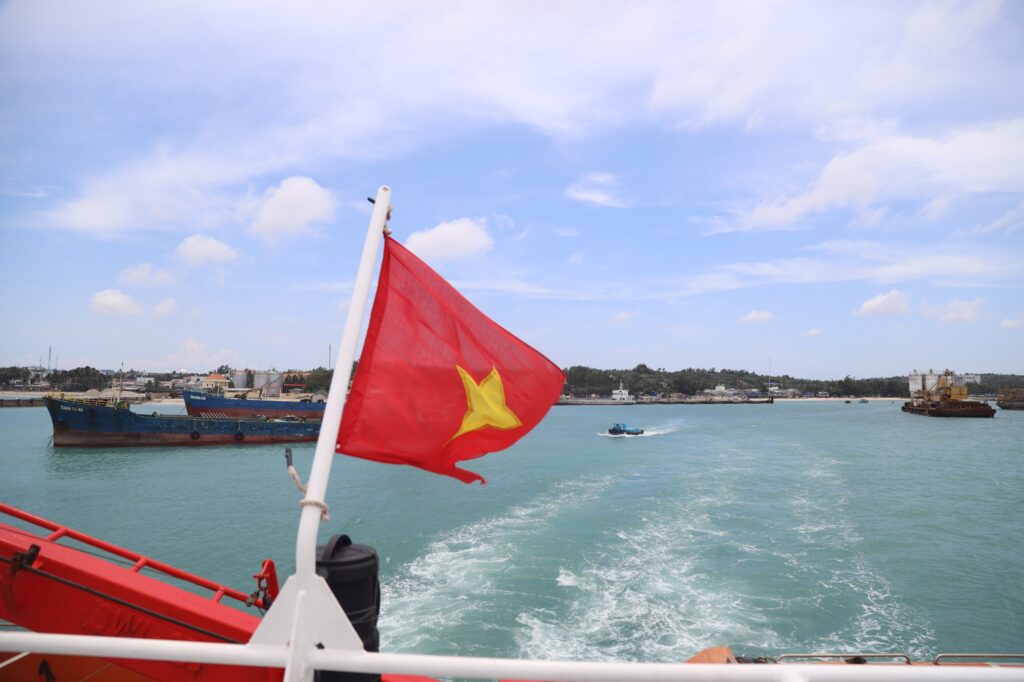Whenever passing by Hon Tranh Island, the local people often recall the old legend about the origin of Vung Phat. It is a reddish-brown rocky cove that serves as a spiritual refuge for fishermen going out to sea, and a safe shelter for boats during storms and rough waves. This legend is connected to Linh Quang Temple (a large temple in Tam Thanh commune, recognized by the government as a national cultural heritage site), founded in 1774.
In its early days, the place was just a simple thatched hut standing quietly beside a deserted hill. Around the temple were forests and pristine rocky outcrops suited to a Buddhist sacred site. At the end of the 18th century, a sudden fire destroyed the entire thatched temple, burning most of the precious relics, leaving only some bronze Buddha statues intact. After the fire, Buddhists and local people resolved to rebuild the temple on the original foundation to have a place to worship the Buddha.
One day, people witnessed a strange phenomenon: in a narrow strait near Hon Tranh Island, a sacred rock would emerge on auspicious days and then sink back afterward. Believing it to be a divine sign from the heavens and the Buddha, locals paid close attention and saw the phenomenon repeat several times. Realizing its significance, the Buddhist followers and locals prayed at the temple and then organized a boat procession to Hon Tranh to bring the sacred rock back to Linh Quang Temple, where they carved a statue of the Buddha Shakyamuni to worship. Since then, the place where the sacred rock appeared has been called Vung Phat (Buddha’s Cove).
Another legend says that a statue of the seated Amitabha Buddha, about 1.5 meters tall and carved from floating stone, appeared on the 1st and 15th days of the lunar month, drifting ashore at Mui Ngoai on Hon Tranh Island. After several appearances, the people chose a good day to bring the statue to Linh Quang Temple and coated it with a bright layer of golden paint. Later, according to the story, a group of pirates suddenly invaded the island, thinking the statue was made of solid gold. They seized it and took it to the Phan Ri – Hoa Da area to scrape off the gold, but finding only stone, they threw the statue into the sea. The Amitabha Buddha statue then drifted back to its original place, “returning home with the tide.” Since then, locals have called the spot where the Buddha statue appears Vung Phat.
When visiting Linh Quang Temple, we saw the seated statue of Buddha Shakyamuni (also called Thien Sanh) in a meditative pose, which is still carefully preserved and worshiped. “This stone statue is 121 cm tall, weighs about 300 kg, and is finely crafted with smooth, gentle carving details. The exterior is beautifully gilded with gold lacquer.”
Based on some details from the two legends about Vung Phat, a few points are noteworthy. First, the detail that the stone Buddha statue was carved by the hands of local island artisans and then brought into the temple for worship. Second, the detail that the stone Buddha statue floated from elsewhere but shares identical features with the statue currently worshiped. Third, the place where the sacred rock appears—whether in its original form or carved into a statue—is called Vung Phat.
From this, we can affirm a partial match between folk tales and reality: there is indeed a genuine stone Buddha statue on the island, while its miraculous appearances are matters of spiritual belief. According to local confirmations, Hon Tranh has a type of porous rock that can float on water.
Moreover, according to Mr. Huynh Huy So, when villagers saw the sacred rock rising, they held a procession to bring it in, then took it to Mrs. Huynh Thi Long’s house (in Trieu Duong commune), a distant relative of Mr. So, to carve the statue.
Thus, we can preliminarily confirm that the statue was made by local people’s own hands, not drifted from elsewhere. The second legend about Vung Phat only deepens the belief in the Buddha’s divine manifestation, always protecting the island’s people. In any case, the stone Buddha statue has been enveloped in a mythical aura. This adds to the sacred and mystical nature of the place called Vung Phat, as well as to the rich cultural tradition of Linh Quang Temple.










